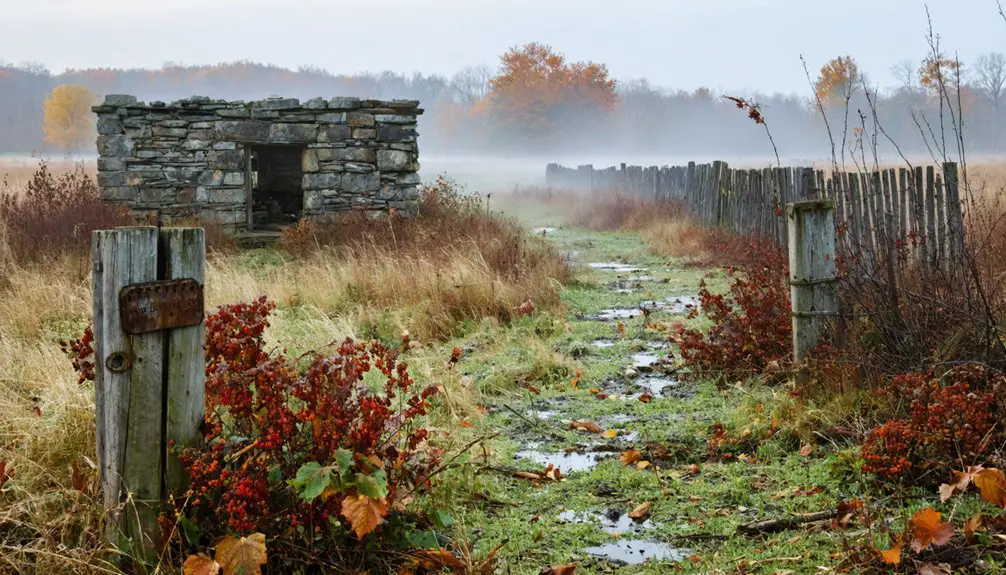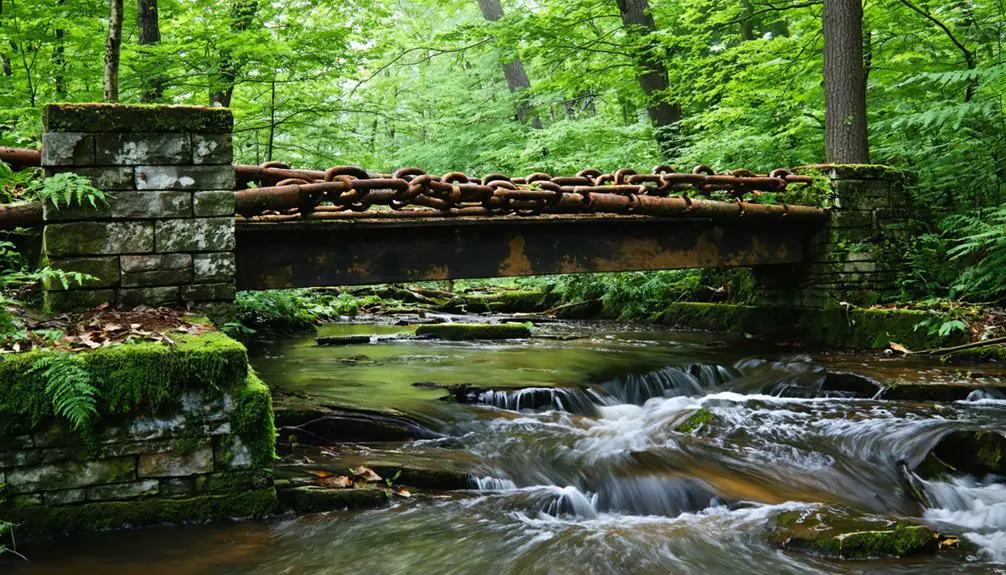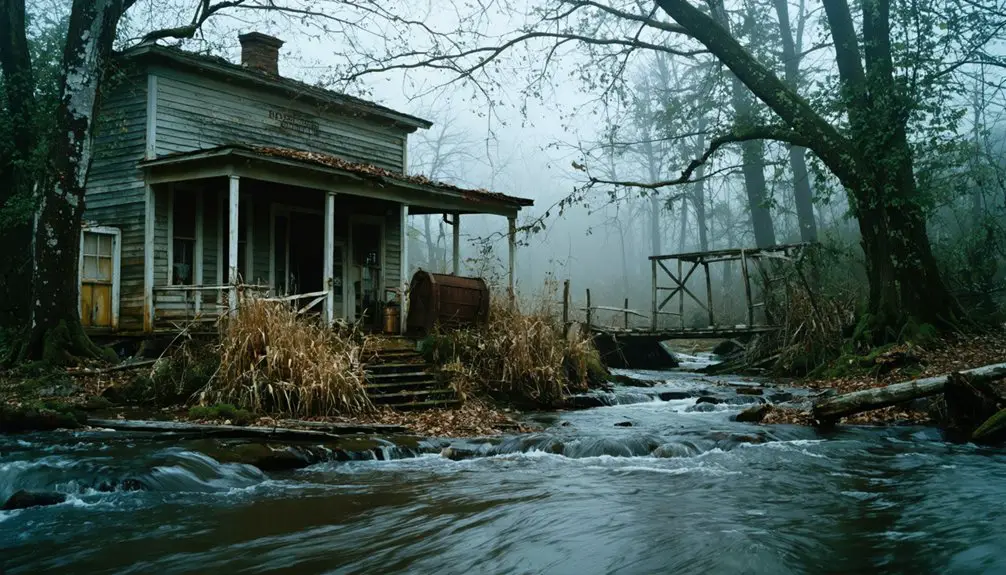You’ll find Whiskey Creek, Michigan isn’t truly a ghost town, but rather an active residential community that was first settled in 1848-1849. While labeled as abandoned, it’s maintained a steady population from its early farming days through its transformation into a suburban area. During Prohibition, the creek served as a strategic smuggling point, with bootlegging operations generating millions in Detroit’s illegal liquor trade. The community’s fascinating history runs much deeper than its ghost town reputation suggests.
Key Takeaways
- Whiskey Creek, Michigan is incorrectly labeled as a ghost town, maintaining an active residential community since its 1848 establishment.
- The community survived the logging era decline and continues to support local businesses, including the Whiskey Creek Tavern.
- Residential development surged in the 1960s, transforming former agricultural land into planned neighborhoods with modern infrastructure.
- The area features both historical buildings and new developments, with retail shops and gathering spaces serving current residents.
- Despite its ghost town reputation, Whiskey Creek hosts regular community events and maintains diverse housing options.
Origins of the Whiskey Creek Name
While the precise origin of Whiskey Creek’s name remains somewhat mysterious, historical records indicate the settlement adopted its name from the tributary that enters Lake Michigan, where the first pioneers established their community around 1848-1849.
You’ll find the creek’s significance as a settler landmark deeply woven into the area’s early development. The waterway served as a vital reference point for travelers and became officially recognized when the local government organized the tripartite township structure in 1855. Similar to the Plat River Road development, the creek became an essential transportation route for early settlers. Like many early Michigan settlements, the community eventually became a ghost town when economic shifts forced residents to seek opportunities elsewhere.
As one of Oceana County’s earliest settlements, the creek’s name reflects the European-American naming conventions of the time. While local folklore might suggest connections to spirits or moonshine, there’s no direct evidence supporting this – the name more likely stems from the settlers’ practice of naming communities after prominent geographical features.
The Truth Behind the Ghost Town Label
While you might hear Whiskey Creek called a ghost town, this label doesn’t accurately reflect its current status as an active residential community.
First settlement at Whiskey Creek began around 1848-1849, marking the earliest established community in Oceana County. The area’s development followed a common Michigan pattern: it emerged during the logging era, experienced economic changes when timber resources declined, but never fully transformed into an abandoned settlement. Like many communities documented in Michigan Place Names, Whiskey Creek has preserved its historical identity while maintaining its residential character.
Rather than becoming a true ghost town, Whiskey Creek adapted over time, maintaining a small but persistent population base that continues to call this historic region home.
Not A Ghost Town
Despite its popular designation as a ghost town, Whiskey Creek maintains an active year-round population with inhabited homes, functioning utilities, and regular visitor traffic.
You’ll find local activities throughout the seasons, from hiking and outdoor recreation to community events that keep the area’s cultural heritage alive. Similar to Bete Grise Harbor, Whiskey Creek serves as a cherished destination for boaters seeking shelter during inclement weather.
Unlike one-industry towns that historically vanished due to economic downturns, Whiskey Creek’s maintained infrastructure, occupied properties, and preserved landmarks tell a different story.
While the region has experienced economic shifts away from traditional industries like mining and logging, it hasn’t succumbed to total desertion.
Instead, you’ll discover a transformed community that’s adapted to new purposes, including recreation and conservation.
The area’s continued maintenance, seasonal tourism, and persistent local presence firmly contradict the misconceptions about its ghost town status.
Historical Development Path
Unlike many ghost towns born from mining booms and busts, Whiskey Creek’s development path began with agriculture in the early 1900s.
You’ll find its historical significance rooted in tomato fields and nurseries that flourished between 1909 and 1925, when key land purchases established the area’s foundations.
The community’s real transformation kicked off in the 1960s when the Hauk property transfer sparked residential development.
Michigan Sales & Development Corp. built 391 homes between 1963 and 1968, while the establishment of fire districts in 1965 demonstrated community resilience through infrastructure growth.
Further development continued with the construction of McGregor Boulevard in 1915, which greatly improved transportation access to Fort Myers.
Similar to the Grand River Indian Trail that once connected Detroit to Grand Rapids, these transportation routes were vital to the area’s growth and commerce.
What you’re seeing today reflects deliberate planning rather than abandonment – a steady evolution from farmland to suburban living, supported by volunteer-driven services and carefully planned community structures that continue to shape the area’s identity.
Active Residential Community
As you explore today’s Whiskey Creek, you’ll discover a thriving residential community that defies its “ghost town” label.
Housing diversity thrives here, from renovated upper-level apartments to spacious single-family homes, while community engagement flourishes through new gathering spaces like the 236 Coffee Club. The Whiskey Creek Tavern, which opened in July 2024, serves as a central gathering spot for locals. The community’s executive-length golf course, opened in 1972, remains a centerpiece of recreational activity.
Local entrepreneurs are breathing new life into historic buildings, creating affordable housing options that attract teachers and traveling nurses.
- Renovated residential units above bustling commercial spaces
- Family-oriented homes featuring 4 bedrooms and modern amenities
- Active campground offering swimming, trails, and disc golf
- Retail shops and services supporting daily resident needs
- Social spaces fostering neighbor connections and local commerce
Prohibition Era Activities and Local Legends
While Michigan began Prohibition three years before the rest of the nation in 1917, Whiskey Creek quickly emerged as a strategic smuggling point in the Upper Thumb region.
You’ll find bootlegging legends centered around this remote waterway, where the Kernan family’s cattle grazing land provided perfect cover for clandestine operations.
The creek’s marshy terrain and secluded shoreline made it an ideal landing spot for Canadian liquor shipments. As part of Detroit’s massive illegal liquor trade network, Whiskey Creek joined other waterways like Lake St. Clair in supplying the thirsty city’s 20,000 speakeasies.
Local law enforcement struggled to control the smuggling routes, with some officials even participating in the trade. By 1929, Detroit’s rumrunning had become so profitable it ranked as the city’s second-largest industry, generating $215 million annually.
Early Land Development and Property Records

You’ll find that Whiskey Creek’s property records trace major changes starting with the 1941 deed exchange between Connecticut’s Harriet Lander Greenway and Florida’s Hauk family.
In 1960, M & O Building Co. purchased the Hauk property and launched Michigan Homes’ residential expansion, transforming raw land into planned neighborhoods.
Property Deed Transfers 1941
The 1941 property deed transfers in Whiskey Creek reflected significant regional land development patterns emerging across Michigan’s Shelby Township area.
You’ll find property ownership shifting from rural agricultural lands to residential and industrial parcels as deed registries documented the area’s transformation. The influence of Packard Proving Grounds and wartime activities sparked increased property exchanges, while new street plattings south of 21 Mile Road signaled growing development momentum.
- Weathered deed books in county archives hold handwritten transfer records
- Newly platted streets carved through former farmlands
- Tank testing grounds stretched across converted agricultural fields
- Property lines redrawn as large parcels subdivided into smaller lots
- Rural landscape giving way to planned residential developments
Michigan Homes Expansion 1960s
During Michigan’s early 1960s housing boom, rural and suburban development transformed the state’s residential landscape as approximately 4.2 million new housing units sprang up on rural nonfarm land nationwide.
You’d find housing trends reflected in Michigan’s expanding suburbs, where developers carved new residential zones from former farmland, particularly around Detroit’s metropolitan area.
If you’d explored the state’s rural development patterns then, you’d notice about half the existing homes dated before 1929, but that was changing fast.
The construction pace picked up considerably, with both permanent residences and seasonal homes dotting northern Michigan’s recreational areas.
Private homebuilding thrived, averaging 420 new units annually in parts of the Upper Peninsula alone, while standardized mortgages made it easier for buyers to finance their piece of Michigan’s housing expansion.
Residential Growth Through 1980
From 1960 to 1980, Whiskey Creek transformed from agricultural farmland into a thriving residential community through strategic land acquisitions and planned development.
You’ll find that Michigan Sales & Development Corp. led the initial residential expansion by constructing 391 homes by 1968. First Development Corp. of America, later known as U.S. Homes, continued this growth by purchasing Hauk family land and developing Whiskey Creek Country Club Estates.
- Single-family homes sprouted along dirt roads that would become major thoroughfares
- Model homes showcased at McGregor Boulevard’s main entrance drew prospective buyers
- Five-foot buffer walls along Summerlin Boulevard protected property values
- Fire districts emerged to support the growing population’s safety needs
- Community amenities expanded as development blocks progressed from 1 through 11 plus Z-1
Michigan Builders Shape the Community

Michigan-based development companies played pivotal roles in transforming Whiskey Creek from rural parcels into a thriving residential community. Through builder collaborations, M & O Building Co. and Michigan Sales & Development Corp. established the area’s residential foundation, constructing 391 homes between 1963 and 1968.
You’ll find their community impact extended beyond just housing. They supported critical infrastructure development, including fire protection through the creation of Iona McGregor and South Trail Fire Districts.
When First Development Corp. of America (later U.S. Homes) took over in 1970, they continued these improvement traditions, adding buffer walls along Summerlin Boulevard and expanding the residential footprint through strategic lot placement.
Their combined efforts created a self-sustaining suburban environment that balanced growth with resident needs.
From Rural Outpost to Suburban Haven
While builders shaped today’s community, the story of Whiskey Creek began as a modest outpost in 1848-1849.
You’ll find that settlement challenges shaped its early character, as pioneers relied on fishing and logging to sustain themselves.
The community transformation from industrial hub to ghost town, and finally to suburban haven, reflects the changing times and values of Michigan’s lakeside communities.
- Weathered fishing boats once dotted the shoreline where pristine docks now stretch
- Old logging paths have become scenic hiking trails through preserved forests
- Former worker cabins gave way to modern lakefront homes
- The once-bustling industrial waterfront now hosts family picnics and boat launches
- Historic Whiskey Creek continues to shape the landscape, flowing past new suburban developments
Fire Districts and Infrastructure Growth
As Whiskey Creek transformed into a suburban community in the 1960s, two essential fire districts emerged to protect the growing population. You’ll find that both Iona McGregor and South Trail Fire Districts, established in 1965, grew from volunteer efforts to become vital pillars of community planning.
The districts’ formation coincided perfectly with major development phases, supporting Michigan Homes’ construction of hundreds of new residences between 1961 and 1968. Fire safety infrastructure proved critical in attracting developers and homebuyers alike.
This careful planning extended beyond fire protection – you’ll see evidence in the construction of Tanglewood School in 1970 and the strategic placement of the McGregor Arch Bridge, which supported the area’s growing infrastructure needs.
These combined elements created the foundation for Whiskey Creek’s sustained residential expansion.
Bootlegging Operations Along the Creek
During Prohibition from 1920 to 1933, Whiskey Creek’s strategic location and remote terrain made it a thriving hub for bootlegging operations.
Nestled in secluded terrain, Whiskey Creek emerged as a bustling center for bootleggers during America’s dry years.
You’ll find that smuggling routes from Canada utilized the creek’s navigable waters, while bootleggers’ tactics incorporated the surrounding marshlands and rocky shores as natural camouflage.
The Purple Gang controlled much of the operation, using the area’s cattle grazing lands as cover for their illicit activities.
- Whiskey sixes racing across frozen waterways under cover of darkness
- Small boats slipping through dredged channels with false customs papers
- Hidden stills nestled in remote creek bends and marshy inlets
- Bootleggers unloading Canadian whiskey at secret shoreline drops
- Local farmers’ fields doubling as clandestine staging grounds
Separating Fact From Fiction
Because historical records remain scarce, you’ll need to carefully distinguish between documented facts and local folklore when exploring Whiskey Creek’s past.
While local legends tell of spilled whiskey barrels and rowdy miners, these stories often blend with tales from other ghost towns, making it challenging to verify what actually happened here.
You’ll find that community tales about Whiskey Creek typically emphasize dramatic events and mysterious circumstances, yet primary sources are limited.
What’s known with more certainty is that the town emerged near natural resources, likely timber or minerals, and followed a common pattern of boom-and-bust seen throughout Michigan.
The settlement’s eventual abandonment probably stemmed from resource depletion, transportation changes, or economic shifts, rather than the more colorful scenarios described in popular folklore.
Frequently Asked Questions
What Happened to the Original Native American Settlements in the Area?
Ever wonder about our region’s Native American tribes? You’ll find they were displaced by European settlers, mining operations, and treaties, with their historical significance diminished as communities scattered or integrated with other groups.
How Deep and Wide Is Whiskey Creek Today?
You’ll find local myths vary about the creek’s true size, but geological features suggest it’s likely a modest stream, typically ranging 3-15 feet wide and rarely deeper than 3 feet.
Are There Any Historic Buildings Still Standing From Before Development?
While 90% of lumber-era structures have vanished, you’ll find one mysterious cabin near the power substations that’s possibly historic, though there’s no official historic preservation status or verified architectural significance.
What Wildlife Species Were Common Before Residential Development Began?
You’d have found rich wildlife diversity before habitat loss, including brook trout, coho salmon, white-tailed deer, ruffed grouse, and diverse small fish like sculpins and sticklebacks in the pristine streams.
Did Any Notable Crimes Occur During the Area’s Early Development?
You’ll find historical records mainly show bootlegging during Prohibition, but there aren’t documented crime incidents involving violence. Beyond illegal alcohol production in the 1920s-30s, only minor land disputes occurred.
References
- https://www.wanderingeducators.com/best/top-10/10-scariest-ghosts-haunt-michigans-shores
- https://whiskeycreeknews.net/44-2/
- https://www.nailhed.com/2019/07/
- https://www.nailhed.com/2019/07/red-alert.html
- https://oceana.mi.us/community/history/
- https://www.youtube.com/watch?v=d_vMU5E1JpI
- https://kids.kiddle.co/List_of_ghost_towns_in_Michigan
- https://en.wikipedia.org/wiki/List_of_ghost_towns_in_Michigan
- https://gandernewsroom.com/2022/01/18/7-michigan-ghost-towns-you-might-not-find-on-your-map/
- https://www.visitkeweenaw.com/things-to-do/museums-history/ghost-towns/



